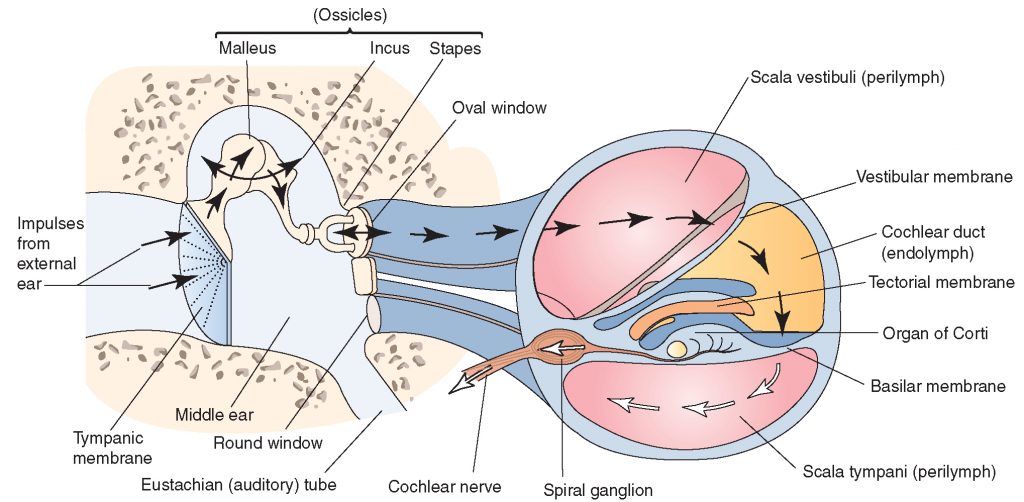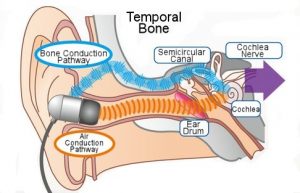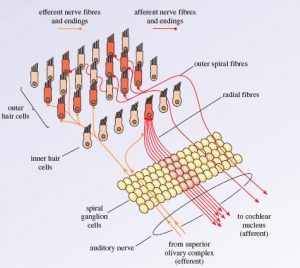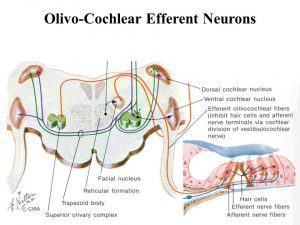4.1.12 What is the impact of Sound Therapy on ear function according to Dr Tomatis?

The impact Sound Therapy has is to rehabilitate and open the entire auditory system to the beneficial impact of sound.
The action of Sound Therapy on the ear and brain feedback loop is to activate the middle ear muscles and retrain them and tone them up to optimal function. This opens the receptivity of the ear to incoming sound.

Long before the recent advent of sophisticated equipment which can measure cochlear emissions, Tomatis insisted that the cochlea was an active, not a passive organ. Current research is proving him correct in this regard.
The conventional theory of sound transmission is that the ossicular chain conveys sound waves from the ear drum to the cochlea. The sound waves activate the cochlear fluid, which activates the cilia, which in turn stimulate the auditory nerve.


Tomatis therapy stresses the importance of bone conduction and the passage of sound from the ear drum directly into the mastoid bone via the bony sulcus on which the ear drum is mounted.
Tomatis sees the ear not as passive receptor but as active creator of the auditory experience. Both motor and sensory (afferent and efferent) nerves supply the ear, so rather than simply receiving external vibrations, the organ of corti in the cochlea sets up its own vibratory state which the external sounds then enter and modify.


To restore normal function to the middle ear muscles, tensor tympani and stapedius, and thus relieve tensor tympani syndrome, Eustachian tube dysfunction and other subtler forms of muscle dysfunction.
Though relatively little has been written about middle ear muscle function, Tensor Tympani Syndrome has been identified by Ramirez 2007 and Klochoff 1979.
Ramirez has stressed the importance of inter-disciplinary diagnosis to achieve clinical success in relation to ear muscular disturbance. He states:
“Tensor tympani muscle physiology and function in the middle ear have been veiled,” (Ramirez, 2007) but
adds, “The tensor tympani muscle (in spite of common belief) is not an inoperative muscle.” We know this due to it “responding electromyographically to strong sounds and vocalization, chewing, swallowing and facial muscle external stimulation.
“The tensor tympani muscle’s normal activity is related to a reflex neurological mechanism known as centrifuge auditory inhibition control (CAIC). This works in sound trauma protection and hearing discrimination of low tones, besides complex co-activation during velopharyngeal (soft palate and pharynx) movements.”
When tensed, the action of the tensor tympani muscle is to pull the malleus (hammer bone) sideways, tensing the ear drum, damping vibration in the ear ossicles (little bones) and thereby reducing the amplitude (loudness) of sounds. This muscle is contracted primarily to dampen the noise produced by chewing. (Compared to the more general dampening function of the stapedius (stirrup) muscle.)
Abnormal, spontaneous action of the tensor tympani muscle due to increased reactivity, excess tension, or spasms has been dubbed by Klochoff as “Tensor Tympani Syndrome”. (Klochoff, 1979) This can lead to some unusual and hard to diagnose hearing disorders.
“The tensor muscle activity does not cause hearing loss …. in the conventional sense. Still the patient may complain of’ “difficulties in catching what people say”.
The prevalence of associated symptoms observed by Klochoff was Fullness/pain in the ear – 83%, Tinnitus – 62%, Distorted hearing – 42%, Tension headache – 88%, Vertigo/ dizziness 80% (Kochoff, 1979.)
Hazell similarly stated:
“We estimate that over 40% of our patients at the tinnitus and hyperacusis centre in London complain of, or remark on, symptoms relating to the tensor tympani muscle. (Hazell, 2003.)
Routinely suggested therapies include muscular relaxation, sedation, counseling and TMJ realignment.
More precise and therapeutically permanent is the re-education of the middle ear muscles postulated by Tomatis and delivered by Sound Therapy. (Tomatis 1991, Thompson 2000, Weeks 1989, Richards, Joudry 2009.)
As well as better hearing, listeners report relief for hyperacusis as the normal responsiveness is restored to the middle ear muscles. (Joudry 2009.)

